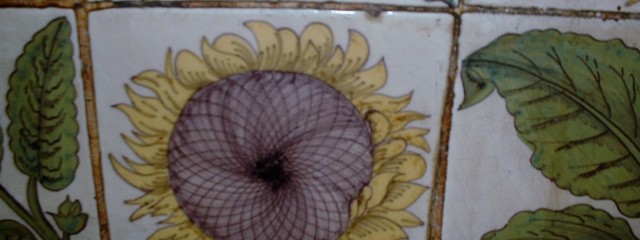Find out more
Digging into history
Community Heritage is a project aimed at unearthing our shared histories and bringing communities together.
Hidden beauties (The tiles – what did we find? – what did we find out? – what did we learn?)
We found three designs, but there may be more. They include a panel of sunflowers and one of daisy like flowers (named Large Aster/Leaf by Elsley).
There is also a panel of an old Dutch tile design, usually known as the ‘tulip and carnation’ design, though, as a member pointed out, the ‘tulips’ are in fact fritillaries.
Read More‘Discovery’ of tiles in the secular hall ballroom
In the course of tracking down some William de Morgan tiles, members of Leicester Secular Society came across a transcript of a radio interview with members of the Society from around 20 years ago.
The interview contained a reference to the tiles in the ballroom having been boarded up. Apparently, the secretary at that time had claimed they made the place look like a butcher’s shop!
Thanks to the determination of Mike Burden, some of these beautiful tiles have at last b
Read More1066 Re-enactment – Saxon School Day 2013
As always, a highlight of the day was the re-enactment of 1066.
This was the year that England changed forever.
From ploughshares to seaxes (Saxon knives), farmers to warriors, the youngsters experienced the peaceful farming life in the Meon Valley before taking up arms to defend king and country.
Read MoreSaxon School Day – 2013
‘My child is still talking about Saxon day’
The Friends of Corhampton Church fourth annual Saxon school day (held on May 9th 2013) again brought smiles and hoots of enjoyment from the children of our villages.
The pupils at Meinstoke infant school were joined by nine older Huscarls (royal guards) from Droxford junior school to learn and celebrate our Saxon heritage. Fifty parents and guests enjoyed the learning, fun and excitement.
Read MoreThe Friends of Corhampton Saxon Church
Corhampton Church is one of the few remaining Saxon churches in regular use and in good repair. The building is Grade I listed and dates from 1020. It has been extensively restored with the help of the Friends of Corhampton Church whose constitution states:
“The Friends are established to assist in the restoration and maintenance of the fabric, contents, and churchyard of Corhampton Church…….. and to preserve and protect it as a place of Christian Worship”.
Read MoreCorporation Oaks Tree Planting
Corporation Oaks was officially opened by a tree planting on 11 February 1850. This was attended by members of the Town Council, the Town Clerk and the Clerk to the Justices.
After the ceremony, the group walked down to St Anne’s Well Road and, because it was a rainy day, then took cabs to the George IV where they had an evening of ‘unalloyed enjoyment’.
Read MoreThe Arboretum guns
On 9 April 1857 the Enclosure Committee reported to the Council that it believed
‘… that some of the large Guns and trophies taken from Russia in the late War might be obtained on application to Her Majesty’s Government recommend that such application be made and that the Guns and trophies if obtained be placed in the Arboretum and be under the care of this Council.’ (NA CA 3616)
Read MoreLace Making at Southwell
Cyril Flowers started work at Carey's as a threading boy in 1929 at 14 years. He was paid 7s/6d (37 1/2 pence) per week, and an extra 6d (2 1/2 pence) for 3 hours on a Saturday.
“There were 46 machines some capable of producing lace 360 inches wide. Some machines had 3,000 bobbins or shuttle that needed threading. When Carey’s closed down in 1956, Cyril was the last man to be paid off and given £25 extra and a fortnights pay.
Read MoreDate: 11 Jul 2013
Comment: 0
The Church of St Wilfrid, Barrow-upon-Trent
From Anglo-Saxon to late 19th/20th Century – the church of St Wilfrid’s in Barrow-upon-Trent seems to have a little bit of everything within its building and its history.
Add to that, the two ‘Black Death’ pits found in the churchyard, and it becomes obvious why Barrow upon Trent Parish History Research Group were keen to have an historical building assessment carried out on their church.
Read MorePopular
No Responses.
No Responses.
No Responses.
Communities
Content Types
© 2013 University of Nottingham - Back to top




















